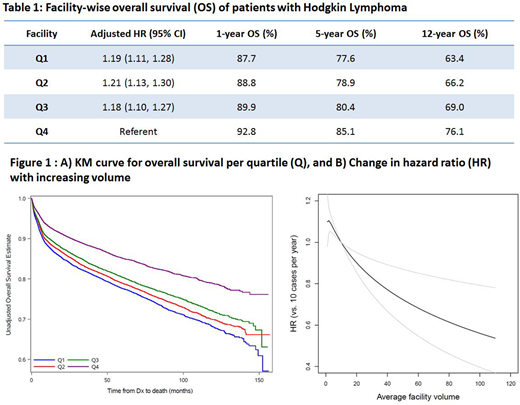Abstract
Background
Hodgkin lymphoma is a rare hematological malignancy, with 8,500 new cases per year in the United States. Prior studies in oncology have shown that higher patient volume, whether at the treatment facility or provider level, is associated with reduced mortality and improved overall survival (OS). We used a national oncology data set to test our hypothesis that a volume-outcome relationship may also exist in classical Hodgkin lymphoma.
Methods
Using the National Cancer Data Base (NCDB), we identified patients diagnosed with classical Hodgkin lymphoma between 2003 and 2014. The NCDB is a nationwide oncology outcomes database for ~70% of newly diagnosed cases from more than 1,500 accredited cancer programs in the United States and Puerto Rico. We classified the facilities by quartiles (Q; mean patients with HL treated per year): Q1: < 3.19, Q2: 3.2 to 5.0, Q3: 5.01 to 9.19, and Q4: ≥9.2. Our primary outcome of interest was all-cause mortality. We used random intercepts to account for clustering of patients within facilities and a Cox regression model to determine the volume-outcome relationship, adjusting for demographic (sex, age, race, ethnicity), socioeconomic (income, education, insurance type), geographic (area of residence, treatment facility location, travel distance), and comorbid (Charlson-Deyo score) factors, as well as year of diagnosis. Kaplan-Meier analysis was performed to examine the impact of patient volume (by quartile) on overall survival.
Results
There were 47,633 patients with classical Hodgkin lymphoma treated at 1,310 facilities. The median age at diagnosis was 40 years, and 54.2% were men. The median annual facility volume was 2.7 patients per year (range, 1 to 42.8). The distribution of facilities according to patient volume was: Q1: 58.4%, Q2: 22.4%, Q3: 13.3%, and Q4: 5.9%. After a median follow-up of 58 months, the highest volume quartile (Q4) had significantly higher 5- and 12-year overall survival rates compared to Q1-Q3 (Table 1). Overall survival by quartile is depicted as a Kaplan-Meier curve (Figure 1). Compared to the patients treated at Q4 facilities, those treated at lower-quartile facilities had a higher risk of death (Q3 hazard ratio [HR], 1.18 [95% CI, 1.10 to 1.27]; Q2 HR, 1.21 [95% CI, 1.13 to 1.30]; Q1 HR, 1.19 [95% CI, 1.11 to 1.28]) after adjustment for the sociodemographic factors discussed in our methods. Multivariable analysis showed that facility volume as a continuous variable was independently associated with all-cause mortality (Figure 2) (P<0.0001). Compared with facilities treating 10 patients per year, facilities treating 20, 30, and 40 patients per year had approximately 10%, 17%, and 23% lower overall mortality rates.
Conclusions
Patients treated for classical Hodgkin lymphoma at higher-volume facilities had a lower risk of mortality compared with those treated at lower-volume facilities. This adds to the growing body of evidence that a volume-outcomes relationship exists in some of the less common hematologic malignancies. Further research is needed to ascertain whether such differences in survival are related to provider-level or facility-level attributes, and whether patients with Hodgkin lymphoma will benefit from referral to high-volume centers.
No relevant conflicts of interest to declare.
Author notes
Asterisk with author names denotes non-ASH members.


